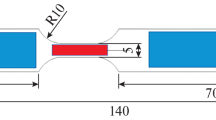Abstract
Fatigue crack growth in compact tension samples of high purity 4140 steel quenched and tempered to various strength levels was investigated. Tempering temperatures of 200, 400, 550, and 700 °C produced yield strengths from 1600 to 875 MPa, respectively. Crack propagation and crack closure were monitored inK-decreasing tests performed underR = 0.05 loading conditions in laboratory air. Results indicated that as the yield strength increased the crack growth rate increased at a given ΔK and ΔKth decreased. Threshold values varied from 2.8 MPa m1/2 (200 °C temper) to 9.5 MPa m1/2 (700 °C temper). Cracks in the 200 °C tempered samples grew by an intergranular mechanism following prior austenite grain boundaries probably caused by hydrogen embrittlement or tempered martensite embrittlement. Tempering above 200 °C produced transgranular fatigue crack growth. The level of crack closure increased with tempering temperature and with crack propagation in a given tempered condition. Crack closure was caused by a combination of plasticity-induced and oxide-induced mechanisms. The use of an effective stress intensity range based on crack closure consolidated the fatigue crack growth curves and the threshold values for all tempering temperatures except 200 °C.
Similar content being viewed by others
References
M.E. Fine and R. O. Ritchie:Fatigue and Microstructure, ASM, Metals Park, OH, 1979, pp. 245–78.
R.O. Ritchie:Metals Science, Aug./Sept. 1977, pp. 368-81.
M. R. James, W. L. Morris, and A. K. Zurek:Fatigue Eng. Mater. Struct., 1983, vol. 6(3), pp. 293–305.
R.O. Ritchie and S. Suresh:Metall. Trans. A, 1982, vol. 13A, pp. 937–40.
D. Davidson and J. Lankford:Fatigue Eng. Mater. Struct., 1983, vol. 6(3), pp. 241–56.
J. Lankford and D. Davidson:Acta Metall., 1983, vol. 31(8), pp. 1273–84.
D. Davidson and J. Lankford:Fatigue Eng. Mater. Struct., 1984, vol. 7(1), pp. 29–39.
D. Davidson and J. Lankford:Am. Soc. Test. Mater. Spec. Tech. Publ. 811, 1983, pp. 371-99.
S. Taira, K. Tanaka, and M. Hosina:Am. Soc. Test. Mater. Spec. Tech. Publ. 675, 1979, pp. 135-73.
K. Minakawa and A.J. McEvily:Scripta Metall., 1981, vol. 15, pp. 633–36.
S Suresh and R.O. Ritchie:Metall. Trans. A, 1982, vol. 13A, pp. 1627–31.
W. Elber:Am. Soc. Test. Mater. Spec. Tech. Publ. 486, 1971, pp. 230-42.
Y. Nakai, K. Tanaka, and T. Nakamichi:Eng. Fract. Mech., 1981, vol. 15, pp. 291–302.
S. Suresh, G. F. Zamisky, and R. O. Ritchie:Metall. Trans. A, 1981, vol. 12A, pp. 1435–43.
R. O. Ritchie, S. Suresh, and C. M. Moss:J. Eng. Mater. Technol., Trans. ASME Ser. H, 1980, vol. 102, p. 293.
A.T. Stewart:Eng. Fract. Mech., 1980, vol. 13, p. 463.
J. Masounave and J.-P. Bailon:Scripta Metall., 1976, vol. 10, pp. 165–70.
H. Suzuki and A.J. McEvily:Metall. Trans. A, 1979, vol. 10A, pp. 475–81.
Am. Soc. Test. Mater. Specification E 647-78T, Appendix II, Proposed ASTM Test Method for Measurement of Fatigue Crack Growth Rates, 1978.
W. F. Deans and C. E. Richards:J. Test. Eval., 1979, vol. 7(3), pp. 147–54.
W. W. Gerberich:Hydrogen in Metals, I.M. Bernstein and A.W. Thompson, eds., ASM, Metals Park, OH, 1974, pp. 115–47.
C.D. Beachem:Metall. Trans., 1972, vol. 3, p. 437.
K. Farrell and A.G. Quarrell:J. Iron Steel Inst., 1964, vol. 202, p. 1002.
G. Krauss:Principles of Heat Treatment of Steel, ASM, Metals Park, OH, 1980, pp. 209–15.
N. Bandyopadhyay and C. J. McMahon, Jr.:Metall. Trans. A, 1983, vol. 14A, pp. 1313–25.
H. L. Ewalds and R. J. H. Wanhill:Fracture Mechanics, Edward Arnold Publishers, London, 1984, pp. 21–22.
Author information
Authors and Affiliations
Additional information
Formerly Graduate Research Assistant, Department of Materials Science and Engineering, Stanford University, Stanford, CA.
Formerly Professor, Department of Materials Science and Engineering, Stanford University, Stanford, CA.
Rights and permissions
About this article
Cite this article
London, B., Nelson, D.V. & Shyne, J.C. The effect of tempering temperature on near- threshold fatigue crack behavior in quenched and tempered 4140 steel. Metall Trans A 19, 2497–2502 (1988). https://doi.org/10.1007/BF02645477
Received:
Issue Date:
DOI: https://doi.org/10.1007/BF02645477




